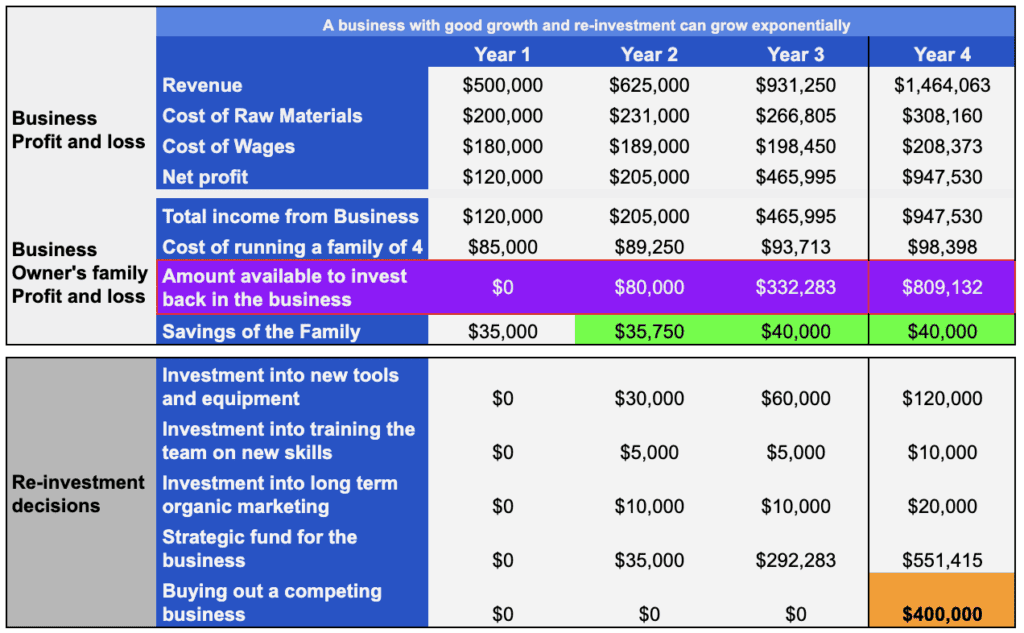In the early years of business, small companies come up against a lot of different challenges, some more daunting than others. In fact, I found that many small businesses face tough challenges early on.
The U.S. Bureau of Labor Statistics revealed that 21% fail in their first year, 28% in two years, and a staggering 48% within a decade. Only 25% survive the past 15 years. You can find a lot more details about this in a detailed study here that I have done about small business failure.
With those survival rates, it’s clear why many entrepreneurs face the early years of business with a sense of anxiety. However, many common problems and obstacles in business are, in fact, resolvable.
Many times, all we need to do is take a step back, assess our pain points, and rethink our strategy.
On that note, we’ll explore the prevalent challenges that small businesses frequently encounter, along with tactical advice on how to overcome them.
There are 5 big challenges that small businesses face with the biggest being cashflow problems
Lets explore all of these in detail and break down the biggest obstacles that small businesses encounter today with some concrete tips to solve each of them.
Obstacle to funding operations due to cashflow issues
Insufficient cash flow or funds is the biggest obstacle in business that can severely impede the progress of any company. Unlike large companies that typically have enough cash flow to manage payroll and maintain operations, small businesses often find themselves in a more precarious financial position.
If one big client fails to make a payment on time, small businesses may struggle to cover their bills and other financial obligations. We’ve heard plenty of tales of entrepreneurs giving up their own salaries to pay employees and vendors.
And sadly, there are a plenty of accounts of small businesses failing because they ran out of money.
How to fix it?

Wouldn’t you like to see a P&L like above for your small business?
As a small business owner in any industry, It’s essential that you use business credit wisely, cut costs wherever possible, and manage cash flow by staying on top of invoices and bookkeeping. More importantly, pay off credit timely to avoid paying higher interest rates or late fees. Apart from these are some time tested principles you must follow.
- Start growing your business organically before investing in expensive marketing
- Calculate you minimum vialble size of customer base that will sustain your business
- Keep costs as low as possible, sleep in your kitchen if you need to
- Dont borrow unless you are certain that you can make more returns than the costs of borrowing
- Grow your business consistently every quarter, every year
If you don’t know how fast your business should grow, you can look at a helpful article on ideal growth rates for different industries here.
Obstacles caused by not hiring the right people
I recently came across a study conducted by the U.S. Chamber of Commerce, which states that there are 33.2 million small businesses in the United States, accounting for about 46% of America’s private sector workforce. But that doesn’t mean that finding qualified, dedicated employees is an easy task.
In many instances, your small business’ salary and benefits package won’t be able to compete with the offerings of large corporations (specially the ego satisfying aspects like free food, massage parlours, pool tables, free candy and many other things)
Moreover, while large companies hire people for specific roles, while you will require workers who can handle a variety of tasks.
Additionally, given the frequent changes in small business environments, you’ll probably need employees with the right mindset to succeed in such an environment.
These factors combined make the process of finding the right employees another challenge for small business owners.
How to fix it?
To tackle the issue of finding quality employees for small businesses, emphasise your unique advantages over larger corporations through the following ways:
- Highlight the potential for greater responsibility, closer working relationships, and professional growth.
- Be open to providing non-monetary benefits like flexible schedules or benefits for professional development.
- Clearly articulate what success means to you and what that success will mean for the employees
- Leverage your network for referrals, both for hiring people as well as for providing career advancing opportunities for those who stuck around with you
- Use skills assessments and behavioral interviews to assess candidates.
- Cultivate a positive and open company culture, over communicate so that people understand you well and have a reason to stick around
- Invest in employee training for specific skills the employees are interested in, collaborate with other business owners so that your employees can get flavour of different businesses and learn more
- Utilise online job platforms and industry-specific websites to promote your company, culture and openings that you have
By implementing these strategies, small business owners can attract the right talent for their unique environments and effectively solve productivity obstacles that they face in business.
Obstacles caused by overload and lack of bandwidth
It’s very common for small business owners to get sucked into the daily operations like customer service, fulfilling orders, covering for employees, and more.
The smaller the business, the more tasks you’re likely to juggle, creating a time crunch that can cause important matters to fall through the cracks.
How to fix it?
You need to get out of the daily minutiae of day-to-day operations so that you can work on realistic and compelling strategies for business growth. Below are some points you can follow to fix this issue:
- Delegating tasks to your deputies for key functions
- Establishing standard operating procedures so that you dont have to guide people for every decision
- Hiring managers to oversee day-to-day affairs and have KPIs against which they will be measured
- Outsourcing non-core functions like accounting, book-keeping
- Prioritising high-impact tasks to be done by yourself
- Automating repeated mundane tasks that can be done digitally, for example, payments
Implementing these time-saving strategies can have a big impact on productivity and overall small business success.
Obstacles caused by not Balancing Quality and Growth

It’s a familiar tale: One day, you celebrate landing a major client, and the next, you’re struggling to meet their demands.
The dilemma then becomes clear—overwork your team or compromise on quality. The challenge lies in scaling your business sustainably without compromising its integrity, ensuring a lasting path to success.
How to fix it?
The key is not obsessing over every detail but focusing on the right ones. For instance, closely monitoring product perfection might not be as important as overseeing customer service, which is a critical aspect of overcoming obstacles in business.
While I worked at amazon from 2015 to 2019, the letter written by Amazon CEO Jeff Bezos in 2016 to his shareholders, in which he stated: “There are many ways to center a business” left a lasting impression and made me reflect.
“You can be competitor-focused, you can be product-focused, you can be technology-focused, you can be business model-focused, and there are more. But in my view, obsessive customer focus is by far the most protective of Day 1 vitality.”
(He refers to “Day 1” as a time of expansion and innovation and “Day 2” as a time of stagnation, irrelevance, and gradual decline.)
Obstacles to growth due to Poor Online Presence
Marketing, in general, can cause a load of challenges for small business owners. Traditional advertising can be costly, while word-of-mouth spreads slowly.
This is where the Internet comes to rescue small businesses by providing them with various channels to attract consumers without spending a fortune.
However, many small businesses underutilize the power of the Internet and don’t do enough with their online presence.
Sure, you might have a website, but is it optimized for search engines and mobile devices? Does it truly convert visitors?
Beyond the website, a strong online footprint encompasses more: proactive engagement on platforms like Facebook and Twitter, as well as vigilant monitoring of review sites like Yelp, where a single negative review can dent your image.
How to fix it?
To enhance the online presence of your small business, you can implement these effective strategies:
- Start with a professional website that’s user-friendly and mobile-responsive. Optimize content for search engines, using relevant keywords and quality, informative content.
- Create business listings or pages on social media platforms like Facebook, Instagram, Twitter, etc, to engage with the audience and share valuable content.
- Invest in online advertising, like pay-per-click (PPC) campaigns or social media ads, to expand reach.
- Encourage customer reviews and manage your online reputation.
- Collaborate with influencers or strategic partners for cross-promotion, overcoming this digital obstacle in business through mutual support.
- Regularly update and maintain your online presence, keeping it aligned with your brand and mission.
By consistently improving your digital footprint, your small business can attract more customers and grow.
Some business success stories where businesses have overcome their obstacles
I often draw inspiration from real-life success stories. Despite the obstacles, I believe that small businesses can overcome adversity and achieve remarkable growth.
Let’s explore some of these success stories and derive actionable takeaways that can inspire and guide other small businesses on their journey:
1. Zoom, by Eric Yuan
Zoom, the popular video calling software, serves diverse audiences from high school to Silicon Valley and Wall Street. As video calling has improved on mobile phones over the last decade, the shift to mobile devices now constitutes 51% of web traffic. Yet, it’s worth noting that 49% of video calling still occurs on computers.
While mobile work is on the rise, millions still rely on computers. Zoom’s proactive approach, focusing on both desktop and mobile, boosted its quarterly revenue by over 1000% since 2019, making it a timely and reliable choice for connecting with team members and loved ones nationwide.
Key Takeaways:
- Embrace existing markets.
- Prioritize user experience and continuous improvement.
2. Red Rabbit, by Rhys Powell
Red Rabbit, led by Rhys Powell, has been nourishing schoolchildren across the USA for over 15 years. An entrepreneur with a background in computer science transitioned his business from catering services to education and charity.
He recognized an opportunity in the US National School Lunch Program, which reimbursed schools up to $3 per meal. Powell aimed to offer nutritious meals for under $3 per child, resulting in a win-win scenario of significant impact.
Key Takeaways:
- Embrace your business values.
- Continuously explore new funding sources for your small business.
3. DC Mosquito Squad, by Damian Sanchez
Damian Sanchez recognized the consistent demand for pest control services in Washington D.C. However, his small business faced challenges in lead management, affecting productivity. To overcome this, Sanchez invested in software to automate sales and marketing, streamlining operations.

With improved data tracking, he accelerated team onboarding, simplified customer renewals, and successfully scaled his small business into a much larger venture, which services an average of 500 calls a day.
Key Takeaways:
- Employ automation systems
- Analyze pain points to identify growth solutions for your company.
Owning a small business can be extremely rewarding. But, it can be overwhelming at times as well because of the various challenges that arise with growth.
While I recommend embracing the hurdles as learning opportunities, it’s crucial to remain informed and proactive.
With my various studies and research explored so far, I’ve learned that many of these challenges can be mitigated with the proper planning and strategy. So put on your entrepreneurial cape and tackle each obstacle head-on.
Cheers to every obstacle that you overcome!


